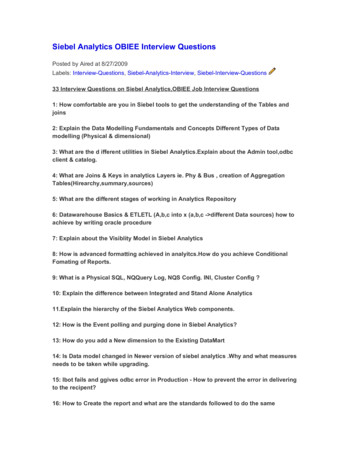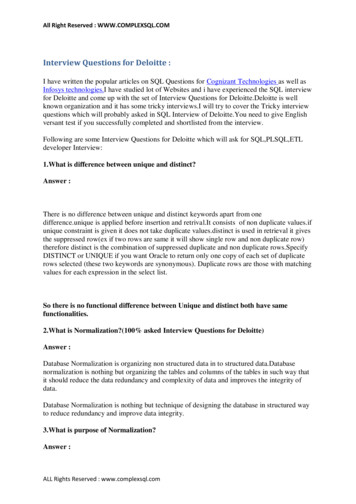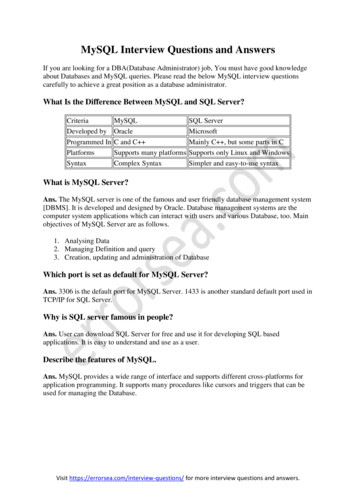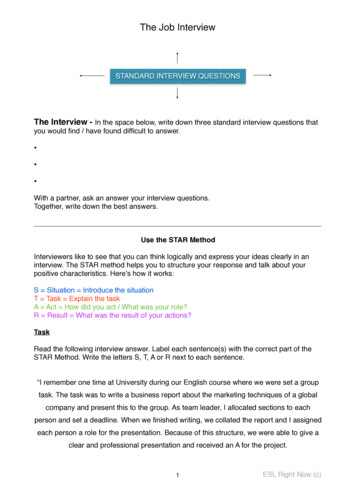
Transcription
C Interview QuestionsCompiled by Dr. Fatih Kocan, Wael Kdouh, and Kathryn Pattersonfor the Data Structures in C course(CSE 3358)Spring 2008
! "# % & '(!) * , - . / '( 0 ' 123 , *&45 . 6 7 1) % 8 9 :; . ?('8 @ BA%A8 ? 1CED % F GC5- % ?(945 H I J('K % F E :7 CE % :("
Q: Is it possible to have Virtual Constructor? If yes, how? If not, Why not possible?A: There is nothing like Virtual Constructor. The Constructor can’t be virtual as the constructoris a code which is responsible for creating an instance of a class and it can’t be delegated toany other object by virtual keyword means.Q: What is constructor or ctor?A: Constructor creates an object and initializes it. It also creates vtable for virtual functions. It isdifferent from other methods in a class.Q: What about Virtual Destructor?A: Yes there is a Virtual Destructor. A destructor can be virtual as it is possible as at runtimedepending on the type of object caller is calling to, proper destructor will be called.Q: What is the difference between a copy constructor and an overloaded assignment operator?A: A copy constructor constructs a new object by using the content of the argument object. Anoverloaded assignment operator assigns the contents of an existing object to another existingobject of the same class.Q: Can a constructor throws an exception? How to handle the error when the constructor fails?A:The constructor never throws an error.Q: What is default constructor?A: Constructor with no arguments or all the arguments has default values.Q: What is copy constructor?A: Constructor which initializes the it's object member variables ( byshallow copying) with another object of the same class. If you don't implement one in your classthen compiler implements one for you. for example:(a) Boo Obj1(10); // calling Boo constructor(b) Boo Obj2(Obj1); // calling boo copy constructor(c) Boo Obj2 Obj1;// calling boo copy constructorQ: When are copy constructors called?A: Copy constructors are called in following cases:(a) when a function returns an object of thatclass by value(b) when the object of that class is passed byvalue as an argument to a function(c) when you construct an object based on anotherobject of the same class(d) When compiler generates a temporary object
Q: Can a copy constructor accept an object of the same class as parameter, instead of referenceof the object?A: No. It is specified in the definition of the copy constructor itself. It should generate an error ifa programmer specifies a copy constructor with a first argument that is an object and not areference.Q: What is conversion constructor?A: constructor with a single argument makes that constructor as conversion ctor and it can beused for type conversion.for example:class Boo{public:Boo( int i );};Boo BooObject 10 ; // assigning int 10 Boo objectQ:What is conversion operator?A:class can have a public method for specific data type conversions.for example:class Boo{double value;public:Boo(int i )operator double(){return value;}};Boo BooObject;double i BooObject; // assigning object to variable i of type double.now conversion operator gets called to assign the value.Q: How can I handle a constructor that fails?A: throw an exception. Constructors don't have a return type, so it's not possible to use returncodes. The best way to signal constructor failure is therefore to throw an exception.Q: How can I handle a destructor that fails?A: Write a message to a log- le. But do not throw an exception. The C rule is that you mustnever throw an exception from a destructor that is being called during the "stack unwinding"process of another exception. For example, if someone says throw Foo(), the stack will beunwound so all the stack frames between the throw Foo() and the } catch (Foo e) { will getpopped. This is called stack unwinding. During stack unwinding, all the local objects in all
those stack frames are destructed. If one of those destructors throws an exception (say it throws aBar object), the C runtime system is in a no-win situation: should it ignore the Bar and end upin the } catch (Foo e) { where it was originally headed? Should it ignore the Foo and look for a }catch (Bare) { handler? There is no good answer:either choiceloses information. So the C language guarantees that it will call terminate() at this point, andterminate() kills the process. Bang you're dead.Q: What is Virtual Destructor?A: Using virtual destructors, you can destroy objects without knowing their type - the correctdestructor for the object is invoked using the virtual function mechanism. Note that destructorscan also be declared as pure virtual functions for abstract classes. if someone will derive fromyour class, and if someone will say "new Derived", where "Derived" is derived from your class,and if someone will say delete p, where the actual object's type is "Derived" but the pointer p'stype is your class.Q: Can a copy constructor accept an object of the same class as parameter, instead of referenceof the object?A: No. It is specified in the definition of the copy constructor itself. It should generate an error ifa programmer specifies a copy constructor with a first argument that is an object and not areference.Q: What's the order that local objects are destructed?A: In reverse order of construction: First constructed, last destructed.In the following example, b's destructor will be executed first, then a's destructor:void userCode(){Fred a;Fred b;.}Q: What's the order that objects in an array are destructed?A: In reverse order of construction: First constructed, last destructed.In the following example, the order for destructors will be a[9], a[8], ., a[1], a[0]:void userCode(){Fred a[10];.}Q: Can I overload the destructor for my class?
A: No.You can have only one destructor for a class Fred. It's always called Fred:: Fred(). It never takesany parameters, and it never returns anything.You can't pass parameters to the destructor anyway, since you never explicitly call a destructor(well, almost never).Q: Should I explicitly call a destructor on a local variable?A: No!The destructor will get called again at the close } of the block in which the local was created.This is a guarantee of the language; it happens automagically; there's no way to stop it fromhappening. But you can get really bad results from calling a destructor on the same object asecond time! Bang! You're dead!Q: What if I want a local to "die" before the close } of the scope in which it was created? Can Icall a destructor on a local if I really want to?A: No! [For context, please read the previous FAQ].Suppose the (desirable) side effect of destructing a local File object is to close the File. Nowsuppose you have an object f of a class File and you want File f to be closed before the end of thescope (i.e., the }) of the scope of object f:void someCode(){File f;.insert code that should execute when f is still open.We want the side-effect of f's destructor here!.insert code that should execute after f is closed.}There is a simple solution to this problem. But in the mean time, remember: Do not explicitlycall the destructor!Q: OK, OK already; I won't explicitly call the destructor of a local; but how do I handle theabove situation?A: Simply wrap the extent of the lifetime of the local in an artificial block {.}:void someCode(){{
File f;.insert code that should execute when f is still open.} f's destructor will automagically be called here!.insert code here that should execute after f is closed.}Q: What if I can't wrap the local in an artificial block?A: Most of the time, you can limit the lifetime of a local by wrapping the local in an artificialblock ({.}). But if for some reason you can't do that, add a member function that has a similareffect as the destructor. But do not call the destructor itself!For example, in the case of class File, you might add a close() method. Typically the destructorwill simply call this close() method. Note that the close() method will need to mark the Fileobject so a subsequent call won't re-close an already-closed File. E.g., it might set thefileHandle data member to some nonsensical value such as -1, and it might check at thebeginning to see if the fileHandle is already equal to -1:class File {public:void close(); File();.private:int fileHandle ; // fileHandle 0 if/only-if it's open};File:: File(){close();}void File::close(){if (fileHandle 0) {.insert code to call the OS to close the file.fileHandle -1;}}Note that the other File methods may also need to check if the fileHandle is -1 (i.e., check if theFile is closed).Note also that any constructors that don't actually open a file should set fileHandle to -1.Q: But can I explicitly call a destructor if I've allocated my object with new?A: Probably not.
Unless you used placement new, you should simply delete the object rather than explicitlycalling the destructor. For example, suppose you allocated the object via a typical newexpression:Fred* p new Fred();Then the destructor Fred:: Fred() will automagically get called when you delete it via:delete p; // Automagically calls p- Fred()You should not explicitly call the destructor, since doing so won't release the memory that wasallocated for the Fred object itself. Remember: delete p does two things: it calls the destructorand it deallocates the memory.Q: What is "placement new" and why would I use it?A: There are many uses of placement new. The simplest use is to place an object at a particularlocation in memory. This is done by supplying the place as a pointer parameter to the new part ofa new expression:#include // Must #include this to use "placement new"#include "Fred.h" // Declaration of class Fredvoid someCode(){char memory[sizeof(Fred)]; // Line #1void* place memory; // Line #2Fred* f new(place) Fred(); // Line #3 (see "DANGER" below)// The pointers f and place will be equal.}Line #1 creates an array of sizeof(Fred) bytes of memory, which is big enough to hold a Fredobject. Line #2 creates a pointer place that points to the first byte of this memory (experienced Cprogrammers will note that this step was unnecessary; it's there only to make the code moreobvious). Line #3 essentially just calls the constructor Fred::Fred(). The this pointer in the Fredconstructor will be equal to place. The returned pointer f will therefore be equal to place.ADVICE: Don't use this "placement new" syntax unless you have to. Use it only when you reallycare that an object is placed at a particular location in memory. For example, when yourhardware has a memory-mapped I/O timer device, and you want to place a Clock object at thatmemory location.DANGER: You are taking sole responsibility that the pointer you pass to the "placement new"
operator points to a region of memory that is big enough and is properly aligned for the objecttype that you're creating. Neither the compiler nor the run-time system make any attempt tocheck whether you did this right. If your Fred class needs to be aligned on a 4 byte boundary butyou supplied a location that isn't properly aligned, you can have a serious disaster on your hands(if you don't know what "alignment" means, please don't use the placement new syntax). Youhave been warned.You are also solely responsible for destructing the placed object. This is done by explicitlycalling the destructor:void someCode(){char memory[sizeof(Fred)];void* p memory;Fred* f new(p) Fred();.f- Fred(); // Explicitly call the destructor for the placed object}This is about the only time you ever explicitly call a destructor.Note: there is a much cleaner but more sophisticated way of handling the destruction / deletionsituation.Q: When I write a destructor, do I need to explicitly call the destructors for my member objects?A: No. You never need to explicitly call a destructor (except with placement new).A class's destructor (whether or not you explicitly define one) automagically invokes thedestructors for member objects. They are destroyed in the reverse order they appear within thedeclaration for the class.class Member {public: Member();.};class Fred {public: Fred();.private:Member x ;Member y ;Member z ;
};Fred:: Fred(){// Compiler automagically calls z . Member()// Compiler automagically calls y . Member()// Compiler automagically calls x . Member()}Q: When I write a derived class's destructor, do I need to explicitly call the destructor for mybase class?A: No. You never need to explicitly call a destructor (except with placement new).A derived class's destructor (whether or not you explicitly define one) automagically invokes thedestructors for base class subobjects. Base classes are destructed after member objects. In theevent of multiple inheritance, direct base classes are destructed in the reverse order of theirappearance in the inheritance list.class Member {public: Member();.};class Base {public:virtual Base(); // A virtual destructor.};class Derived : public Base {public: Derived();.private:Member x ;};Derived:: Derived(){// Compiler automagically calls x . Member()// Compiler automagically calls Base:: Base()}Note: Order dependencies with virtual inheritance are trickier. If you are relying on orderdependencies in a virtual inheritance hierarchy, you'll need a lot more information than is in this
FAQ.Q: Is there any difference between List x; and List x();?A: A big difference!Suppose that List is the name of some class. Then function f() declares a local List object calledx:void f(){List x; // Local object named x (of class List).}But function g() declares a function called x() that returns a List:void g(){List x(); // Function named x (that returns a List).}Q: Can one constructor of a class call another constructor of the same class to initialize the thisobject?A: Nope.Let's work an example. Suppose you want your constructor Foo::Foo(char) to call anotherconstructor of the same class, say Foo::Foo(char,int), in order that Foo::Foo(char,int) would helpinitialize the this object. Unfortunately there's no way to do this in C .Some people do it anyway. Unfortunately it doesn't do what they want. For example, the lineFoo(x, 0); does not call Foo::Foo(char,int) on the this object. Instead it calls Foo::Foo(char,int) toinitialize a temporary, local object (not this), then it immediately destructs that temporary whencontrol flows over the ;.class Foo {public:Foo(char x);Foo(char x, int y);.};Foo::Foo(char x){
.Foo(x, 0); // this line does NOT help initialize the this object!!.}You can sometimes combine two constructors via a default parameter:class Foo {public:Foo(char x, int y 0); // this line combines the two constructors.};If that doesn't work, e.g., if there isn't an appropriate default parameter that combines the twoconstructors, sometimes you can share their common code in a private init() member function:class Foo {public:Foo(char x);Foo(char x, int y);.private:void init(char x, int y);};Foo::Foo(char x){init(x, int(x) 7);.}Foo::Foo(char x, int y){init(x, y);.}void Foo::init(char x, int y){.}BTW do NOT try to achieve this via placement new. Some people think they can say new(this)Foo(x, int(x) 7) within the body of Foo::Foo(char). However that is bad, bad, bad. Please don'twrite me and tell me that it seems to work on your particular version of your particular compiler;it's bad. Constructors do a bunch of little magical things behind the scenes, but that badtechnique steps on those partially constructed bits. Just say no.
Q: Is the default constructor for Fred always Fred::Fred()?A: No. A "default constructor" is a constructor that can be called with no arguments. Oneexample of this is a constructor that takes no parameters:class Fred {public:Fred(); // Default constructor: can be called with no args.};Another example of a "default constructor" is one that can take arguments, provided they aregiven default values:class Fred {public:Fred(int i 3, int j 5); // Default constructor: can be called with no args.};Q: Which constructor gets called when I create an array of Fred objects?A: Fred's default constructor (except as discussed below).class Fred {public:Fred();.};int main(){Fred a[10]; calls the default constructor 10 timesFred* p new Fred[10]; calls the default constructor 10 times.}If your class doesn't have a default constructor, you'll get a compile-time error when you attemptto create an array using the above simple syntax:class Fred {public:Fred(int i, int j); assume there is no default constructor.};
int main(){Fred a[10]; ERROR: Fred doesn't have a default constructorFred* p new Fred[10]; ERROR: Fred doesn't have a default constructor.}However, even if your class already has a default constructor, you should try to use std::vectorrather than an array (arrays are evil). std::vector lets you decide to use any constructor, not justthe default constructor:#includeint main(){std::vector a(10, Fred(5,7)); the 10 Fred objects in std::vector a will be initialized with Fred(5,7).}Even though you ought to use a std::vector rather than an array, there are times when an arraymight be the right thing to do, and for those, you might need the "explicit initialization of arrays"syntax. Here's how:class Fred {public:Fred(int i, int j); assume there is no default constructor.};int main(){Fred a[10] {Fred(5,7), Fred(5,7), Fred(5,7), Fred(5,7), Fred(5,7), // The 10 Fred objects areFred(5,7), Fred(5,7), Fred(5,7), Fred(5,7), Fred(5,7) // initialized using Fred(5,7)};.}Of course you don't have to do Fred(5,7) for every entry you can put in any numbers you want,even parameters or other variables.Finally, you can use placement-new to manually initialize the elements of the array. Warning: it'sugly: the raw array can't be of type Fred, so you'll need a bunch of pointer-casts to do things likecompute array index operations. Warning: it's compiler- and hardware-dependent: you'll need tomake sure the storage is aligned with an alignment that is at least as strict as is required forobjects of class Fred. Warning: it's tedious to make it exception-safe: you'll need to manually
destruct the elements, including in the case when an exception is thrown part-way through theloop that calls the constructors. But if you really want to do it anyway, read up on placementnew. (BTW placement-new is the magic that is used inside of std::vector. The complexity ofgetting everything right is yet another reason to use std::vector.)By the way, did I ever mention that arrays are evil? Or did I mention that you ought to use astd::vector unless there is a compelling reason to use an array?Q: Should my constructors use "initialization lists" or "assignment"?A: Initialization lists. In fact, constructors should initialize as a rule all member objects in theinitialization list. One exception is discussed further down.Consider the following constructor that initializes member object x using an initialization list:Fred::Fred() : x (whatever) { }. The most common benefit of doing this is improvedperformance. For example, if the expression whatever is the same type as member variable x ,the result of the whatever expression is constructed directly inside x the compiler does notmake a separate copy of the object. Even if the types are not the same, the compiler is usuallyable to do a better job with initialization lists than with assignments.The other (inefficient) way to build constructors is via assignment, such as: Fred::Fred() { x whatever; }. In this case the expression whatever causes a separate, temporary object to becreated, and this temporary object is passed into the x object's assignment operator. Then thattemporary object is destructed at the ;. That's inefficient.As if that wasn't bad enough, there's another source of inefficiency when using assignment in aconstructor: the member object will get fully constructed by its default constructor, and thismight, for example, allocate some default amount of memory or open some default file. All thiswork could be for naught if the whatever expression and/or assignment operator causes theobject to close that file and/or release that memory (e.g., if the default constructor didn't allocatea large enough pool of memory or if it opened the wrong file).Conclusion: All other things being equal, your code will run faster if you use initialization listsrather than assignment.Note: There is no performance difference if the type of x is some built-in/intrinsic type, such asint or char* or float. But even in these cases, my personal preference is to set those data membersin the initialization list rather than via assignment for consistency. Another symmetry argumentin favor of using initialization lists even for built-in/intrinsic types: non-static const and nonstatic reference data members can't be assigned a value in the constructor, so for symmetry itmakes sense to initialize everything in the initialization list.Now for the exceptions. Every rule has exceptions (hmmm; does "every rule has exceptions"have exceptions? reminds me of Gdel's Incompleteness Theorems), and there are a couple ofexceptions to the "use initialization lists" rule. Bottom line is to use common sense: if it'scheaper, better, faster, etc. to not use them, then by all means, don't use them. This might happenwhen your class has two constructors that need to initialize the this object's data members in
different orders. Or it might happen when two data members are self-referential. Or when a datamember needs a reference to the this object, and you want to avoid a compiler warning aboutusing the this keyword prior to the { that begins the constructor's body (when your particularcompiler happens to issue that particular warning). Or when you need to do an if/throw test on avariable (parameter, global, etc.) prior to using that variable to initialize one of your thismembers. This list is not exhaustive; please don't write me asking me to add another "Orwhen.". The point is simply this: use common sense.Q: Should you use the this pointer in the constructor?A: Some people feel you should not use the this pointer in a constructor because the object is notfully formed yet. However you can use this in the constructor (in the {body} and even in theinitialization list) if you are careful.Here is something that always works: the {body} of a constructor (or a function called from theconstructor) can reliably access the data members declared in a base class and/or the datamembers declared in the constructor's own class. This is because all those data members areguaranteed to have been fully constructed by the time the constructor's {body} starts executing.Here is something that never works: the {body} of a constructor (or a function called from theconstructor) cannot get down to a derived class by calling a virtual member function that isoverridden in the derived class. If your goal was to get to the overridden function in the derivedclass, you won't get what you want. Note that you won't get to the override in the derived classindependent of how you call the virtual member function: explicitly using the this pointer (e.g.,this- method()), implicitly using the this pointer (e.g., method()), or even calling some otherfunction that calls the virtual member function on your this object. The bottom line is this: evenif the caller is constructing an object of a derived class, during the constructor of the base class,your object is not yet of that derived class. You have been warned.Here is something that sometimes works: if you pass any of the data members in this object toanother data member's initializer, you must make sure that the other data member has alreadybeen initialized. The good news is that you can determine whether the other data member has (orhas not) been initialized using some straightforward language rules that are independent of theparticular compiler you're using. The bad news it that you have to know those language rules(e.g., base class sub-objects are initialized first (look up the order if you have multiple and/orvirtual inheritance!), then data members defined in the class are initialized in the order in whichthey appear in the class declaration). If you don't know these rules, then don't pass any datamember from the this object (regardless of whether or not you explicitly use the this keyword) toany other data member's initializer! And if you do know the rules, please be careful.Q: What is the "Named Constructor Idiom"?A: A technique that provides more intuitive and/or safer construction operations for users of yourclass.The problem is that constructors always have the same name as the class. Therefore the only wayto differentiate between the various constructors of a class is by the parameter list. But if thereare lots of constructors, the differences between them become somewhat subtle and error prone.
With the Named Constructor Idiom, you declare all the class's constructors in the private orprotected sections, and you provide public static methods that return an object. These staticmethods are the so-called "Named Constructors." In general there is one such static method foreach different way to construct an object.For example, suppose we are building a Point class that represents a position on the X-Y plane.Turns out there are two common ways to specify a 2-space coordinate: rectangular coordinates(X Y), polar coordinates (Radius Angle). (Don't worry if you can't remember these; the pointisn't the particulars of coordinate systems; the point is that there are several ways to create aPoint object.) Unfortunately the parameters for these two coordinate systems are the same: twofloats. This would create an ambiguity error in the overloaded constructors:class Point {public:Point(float x, float y); // Rectangular coordinatesPoint(float r, float a); // Polar coordinates (radius and angle)// ERROR: Overload is Ambiguous: Point::Point(float,float)};int main(){Point p Point(5.7, 1.2); // Ambigu
(b) Boo Obj2(Obj1); // calling boo copy constructor (c) Boo Obj2 Obj1;// calling boo copy constructor Q: When are copy constructors called? A: Copy constructors are called in following cases: (a) when a function returns an object of that class by value (b) when the object of that class is passed by value as an argument to a function









![Informatica Interview Questions and Answers [Scenario-Based]](/img/2/informatica-interview-questions-and-answers-scenario-based-1.jpg)

